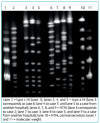INVASIVE NON-TYPE B HAEMOPHILUS INFLUENZAE DISEASE: REPORT OF EIGHT CASES
- PMID: 30624539
- PMCID: PMC6651304
- DOI: 10.1590/1984-0462/;2019;37;2;00006
INVASIVE NON-TYPE B HAEMOPHILUS INFLUENZAE DISEASE: REPORT OF EIGHT CASES
Abstract
Objective: To describe eight cases of invasive non-type b Haemophilus influenzae disease in children admitted to Hospital de Clínicas of Universidade Estadual de Campinas.
Cases description: In 2015, there were eight cases of invasive non-type b H. influenzae disease. We tested the ampicillin sensitivity and beta-lactamase production of the strains identified and performed the genotyping. Molecular typing was determined by Pulsed-Field Gel Electrophoresis. Four patients were diagnosed with bacteremia; in two cases, H. influenzae was detected in the pleural fluid, and two patients had meningitis. Patients with comorbidities represented 37.5% of cases. Except for the strain of one patient - not sent to the reference laboratory -, all were ampicillin-sensitive and non-beta-lactamase-producing. Genotyping identified four non-capsular, one type c, and two type a strains. Molecular typing ruled out nosocomial transmission since all serotypes were distinct regarding genotype.
Comments: The rise in cases of invasive non-type b H. influenzae infection was real. There was no nosocomial transmission, and we found no justification for the increase. These data indicate the need for surveillance to correctly diagnose, monitor, and understand the spectrum of non-type b H. influenzae disease.
Objetivo:: Descrever oito casos de doença invasiva por Haemophilus influenzae não tipo b em crianças internadas no Hospital de Clínicas da Universidade Estadual de Campinas.
Descrição dos casos:: Em 2015, ocorreram oito casos de doença invasiva por H. influenzae não tipo b. Nas cepas identificadas, testou-se a sensibilidade à ampicilina e a produção de betalactamase, e realizou-se a genotipagem. A tipagem molecular foi feita por Pulsed Field Gel Electrophoresis. Em quatro pacientes, o diagnóstico foi de bacteremia; em dois casos, H. influenzae foi identificado em líquido pleural, e dois pacientes tiveram meningite. Comorbidades foram encontradas em 37,5% dos pacientes. Com exceção da cepa de um dos pacientes (que não foi enviada ao laboratório de referência), todas eram sensíveis à ampicilina e não produtoras de betalactamase. A genotipagem identificou quatro cepas não capsulares, uma cepa tipo c e duas cepas tipo a. A tipagem molecular descartou a transmissão intra-hospitalar, já que todos os sorotipos eram distintos quanto ao genótipo.
Comentários:: O aumento dos casos de infecção invasiva por H. influenzae não tipo b foi real. Não houve transmissão intra-hospitalar e não foi encontrada justificativa para o aumento. Esses dados indicam a necessidade de vigilância para diagnosticar corretamente, monitorar e entender o espectro da doença causada por H. influenzae não tipo b.
Conflict of interest statement
The authors declare no conflict of interest.
Figures
Similar articles
-
Haemophilus influenzae type-b and non-b-type invasive diseases in urban children (<5years) of Bangladesh: implications for therapy and vaccination.J Infect. 2008 Mar;56(3):191-6. doi: 10.1016/j.jinf.2007.12.008. J Infect. 2008. PMID: 18280571
-
Invasive Haemophilus influenzae Disease at Texas Children's Hospital, 2011 to 2018.Pediatr Infect Dis J. 2019 Sep;38(9):900-905. doi: 10.1097/INF.0000000000002383. Pediatr Infect Dis J. 2019. PMID: 31107422
-
[Genotyping of ampicillin-resistant Haemophilus influenzae].Zhonghua Er Ke Za Zhi. 2005 Sep;43(9):685-9. Zhonghua Er Ke Za Zhi. 2005. PMID: 16191303 Chinese.
-
Invasive Haemophilus influenzae in the Republic of Ireland.Eur J Clin Microbiol Infect Dis. 1997 May;16(5):377-80. doi: 10.1007/BF01726366. Eur J Clin Microbiol Infect Dis. 1997. PMID: 9228478
-
Analysis of Haemophilus influenzae serotype f isolated from three Japanese children with invasive H. influenzae infection.J Med Microbiol. 2015 Apr;64(Pt 4):355-358. doi: 10.1099/jmm.0.000031. Epub 2015 Feb 5. J Med Microbiol. 2015. PMID: 25657301
Cited by
-
Rapid and sensitive detection of Haemophilus influenzae using multiple cross displacement amplification combined with CRISPR-Cas12a-based biosensing system.Heliyon. 2024 Dec 26;11(1):e41535. doi: 10.1016/j.heliyon.2024.e41535. eCollection 2025 Jan 15. Heliyon. 2024. PMID: 39845011 Free PMC article.
-
Effect of Haemophilus influenzae Type b Vaccination on Nasopharyngeal Carriage Rate in Children, Tehran, 2019.Biomed Res Int. 2021 Mar 15;2021:4923852. doi: 10.1155/2021/4923852. eCollection 2021. Biomed Res Int. 2021. PMID: 33816612 Free PMC article. Clinical Trial.
-
Sepsis Due to Haemophilus influenzae and Masked Influenza A Infection.Cureus. 2022 Feb 21;14(2):e22424. doi: 10.7759/cureus.22424. eCollection 2022 Feb. Cureus. 2022. PMID: 35371694 Free PMC article.
References
-
- Barenkamp SJ. Haemophilus influenzae. In: Feigin RD, Cherry JD, Demmler-Harrison GJ, Kaplan SL, editors. Textbook of pediatric infectious diseases. 6. Philadelphia: Saunders-Elsevier; 2009. pp. 1734–1756.
-
- Gilsdorf JR. What pediatrician should know about non-typeable Haemophilus influenzae. J Infect. 2015;71:S10–S14. - PubMed
-
- MacNeil JR, Cohn AC, Farley M, Mair R, Baumbach J, Bennett N. Current epidemiology and trends in invasive Haemophilus influenzae disease - United States, 1989-2008. Clin Infect Dis. 2011;53:1230–1236. - PubMed
-
- Kuklinska D, Kilian M. Relative proportions of Haemophilus species in the throat of healthy children and adults. Eur J Clin Microbiol. 1984;3:249–252. - PubMed
MeSH terms
LinkOut - more resources
Full Text Sources
Medical


